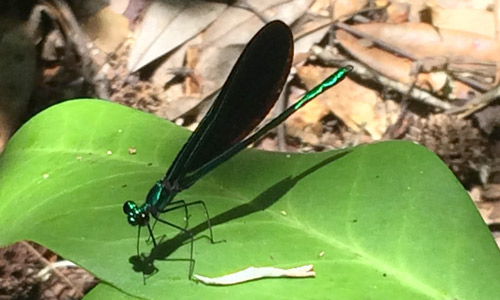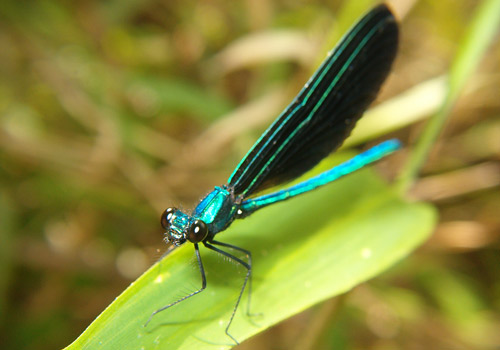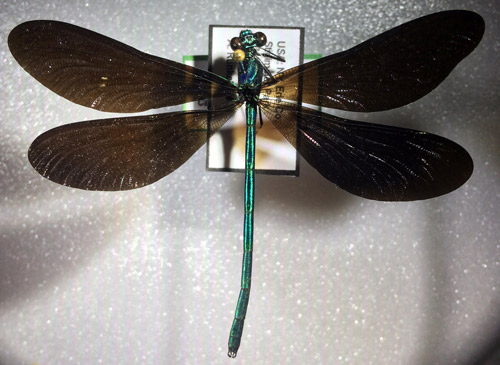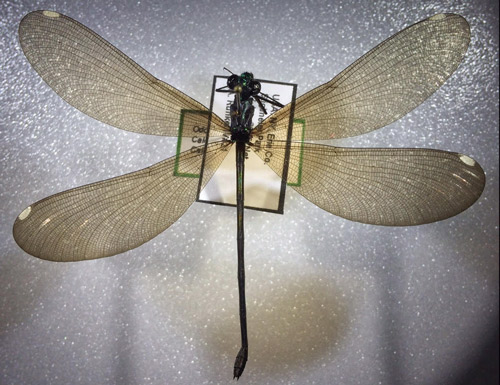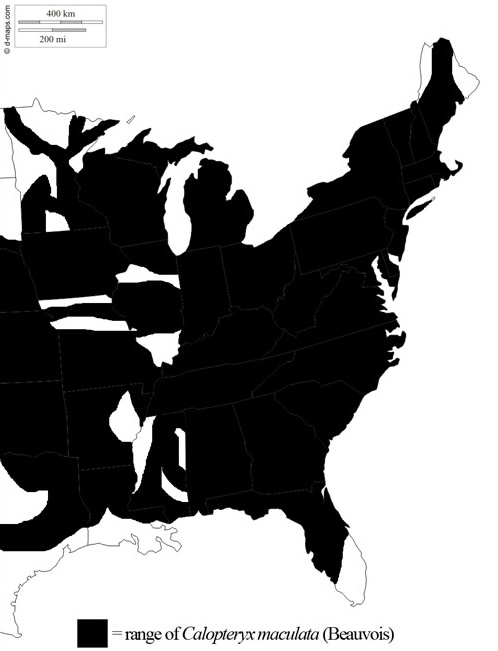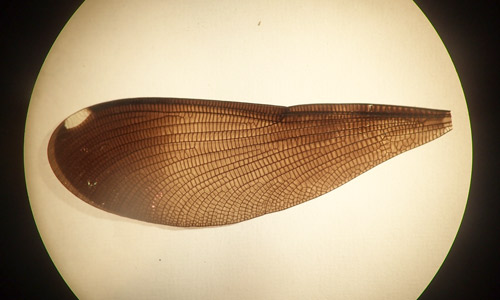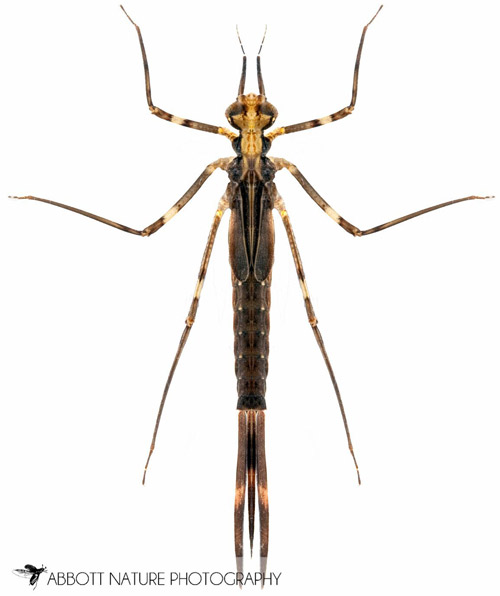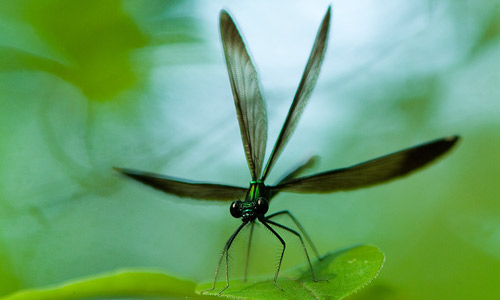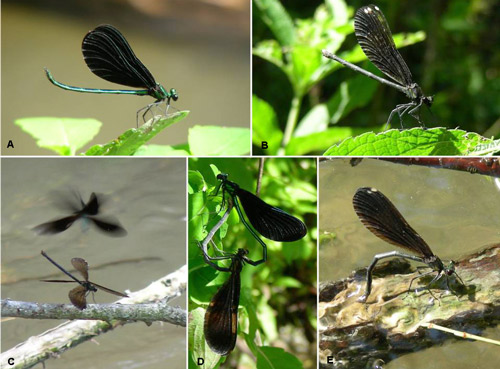common name: ebony jewelwing, black-winged damselfly (suggested common names)
scientific name: Calopteryx maculata (Beauvois, 1807) (Insecta: Odonata: Calopterygidae)
Introduction - Synonymy - Distribution - Description - Life Cycle - Selected References
Introduction (Back to Top)
Calopteryx maculata (Beauvois), the ebony jewelwing, is a large damselfly in the family Calopterygidae that is endemic to eastern North America. The ebony jewelwing has an iridescent green body with dark wings (Figure 1-3). Wings of the male ebony jewelwing are completely black, while wings of the female are smoky bronze with a distinct white spot (pterostigma) at the outer edge of the forewing (Figure 4). The combination of iridescent green body and dark wings distinguish this species from all other damselflies in the family Calopterygidae, and from other damselflies in North America. The ebony jewelwing is not listed as a species of concern.
Figure 1. Male ebony jewelwing, Calopteryx maculata (Beauvois), resting on a leaf (lateral view). Photograph by Alfred Runkel, Florida Medical Entomology Laboratory, University of Florida.
Figure 2. Male ebony jewelwing, Calopteryx maculata (Beauvois), resting on a leaf (lateral view). Photograph by Nathan Burkett-Cadena, Florida Medical Entomology Laboratory, University of Florida.
Figure 3. Pinned male ebony jewelwing, Calopteryx. maculata (Beauvois). Photograph by Alfred Runkel, Florida Medical Entomology Laboratory, University of Florida.
Figure 4. Pinned female ebony jewelwing, Calopteryx maculata (Beauvois) (dorsal view). Photograph by Alfred Runkel, Florida Medical Entomology Laboratory, University of Florida.
Synonymy (Back to Top)
Agrion maculatum Beauvois, 1805
Agrion virginica Westwood, 1837
Calopteryx virginica Westwood, 1837
Calopteryx holosericea Burmeister, 1839
Calopteryx opaca Say, 1839
Calopteryx materna Say, 1839
Calopteryx papilionacea Rambur, 1842
Calopteryx floridana Huggins, 1927
Distribution (Back to Top)
The ebony jewelwing is found throughout most of eastern North America. Its range extends from Canada in the north to Florida in the south and as far west as Wisconsin and Texas (Hassall 2015). In Florida, this damselfly occurs further south on the Gulf Coast (DeSoto County) than the Atlantic Coast (Brevard County) (Figure 5). Adults are typically encountered around shaded freshwater streams with dense vegetation; however, males may occasionally leave these areas to seek new territory (Waage 1972). The ebony jewelwing can often be found resting on leaves or branches in sunny spots of the forest.
Figure 5. Geographic range of the ebony jewelwing, Calopteryx maculata (Beauvois), in the United States. Map by d-maps.com, range from odonatacentral.org and Hassall (2015), edited by Alfred Runkel, Florida Medical Entomology Laboratory, University of Florida.
Description (Back to Top)
Adult male ebony jewelwings are fairly large, with a body length of 39-57 mm (approximately 2.25-3 inches) and a wingspan of 58-76 mm (approximately 1.5-2.25 inches). The body is iridescent dark green, but depending on the light may appear blue, blue-green, or even black. The wings are dark throughout, as a result of the dense network of thick, dark veins and the smoky color of the membrane itself. This species, along with Argia fumipennis Burmeister and Hetaerina titia Drury, are the only damselflies in North America with all-black wings. Recently eclosed adults (emerged from the final molt) tend to have wings that are more brown than black (Waage 1972).
Adult female ebony jewelwings are bluish-green, but lack the brilliant iridescence of the male body (Figure 1-3). Wings are more translucent, appearing light to dark brown rather than black. The wings of the female have a distinct white spot near the wingtip (the pterostigma, Figure 6), which makes it easy to distinguish females from males (Ballou 1984).
Figure 6. The wing of a female ebony jewelwing, Calopteryx maculata (Beauvois). The pterostigma is seen on the top left tip of the wing. Photograph by Eric Blosser, Florida Medical Entomology Laboratory.
While at rest, the ebony jewelwing holds its wings pressed together, vertically, above the thorax, a resting posture shared by most damselflies (Bick and Bick 1977).
Life Cycle (Back to Top)
The cylindrical eggs of the ebony jewelwing are laid in slow moving streams and rivers where the aquatic and predaceous immatures, known as naiads (juveniles), hatch and then hunt for small aquatic prey, including aquatic insects, worms, and small fish. Naiads are olive green to brown in color. Three caudal gills that project from the base of the abdomen regulate oxygen exchange as well as aid in directional swimming (Capinera 2016) (Figure 7). As with the adults, naiads of ebony jewelwings are diurnal and obligate carnivores. To capture prey, they rapidly extend their long, prehensile lower lip (labium) and seize their prey (Capinera 2016).
Damselfly naiads are important prey for many animals, such as fish, birds, and frogs, as well as a variety of aquatic invertebrates (Hussain and Ahmed 2003). Adults are preyed upon by dragonflies, birds, fish, spiders, and frogs (Waage 1972). Naiads undergo 11-12 molts in a single year (Martin 1939), then crawl out of the water onto nearby vegetation to molt a final time into a winged adult, with sexual maturity developing a few days later (Nevin 1929).
Figure 7. Ebony jewelwing, Calopteryx maculata (Beauvois), naiad (dorsal view). Photograph by John and Kendra Abbott, Abbott Nature.
The recently eclosed adult expands its wings by forcing hemolymph (insect blood) into the wing veins using an organ (the pulsatile organ) near the base of the wings. Once the wings are fully extended, the teneral (still soft) body of the recently eclosed adult damselfly must sclerotize (harden) before flight is possible (Silsby 2001). Both adult males and adult females are relatively short-lived, with an average lifespan of just 15-17 days in the wild (Waage 1972). Adult ebony jewelwings hunt for resting arthropods but can also catch prey in midflight (Capinera 2010), such as gnats, mosquitoes, and crane flies, using densely spined legs to trap their prey.
Mating Behavior: Adult males are territorial and compete with one another for high-quality breeding sites around slow moving vegetated streams and rivers. Males attempt to attract females by performing a “cross” display (Figure 8). This display is performed by facing the female and turning the hindwings downward while keeping them perpendicular to the body, then raising the forewings and abdomen, revealing a pale area on the underside of the abdomen.
Figure 8. Male ebony jewelwing, Calopteryx maculata (Beauvois), performing the "cross" display. Photograph by Clay Bolt, Clay Bolt Nature Photography.
Having successfully attracted a female, the male begins his fluttering courtship, which involves whirling his wings and hovering in front of her, followed by walking down her wings to assume his position for copulation (Alcock 1979). When the female accepts the male, the male grasps her prothorax with the copulatory appendages at the end of his abdomen and she responds by raising the tip of her abdomen to the underside of his abdomen (Capinera 2016) (Figure 9 A-E). This heart-shaped arrangement during copulation is known as a mating wheel. The male is equipped with a specialized secondary penis on the underside of his abdomen, which accepts sperm from the primary penis on the tip of the abdomen and is then used to transfer his sperm to the female’s spermatheca (sperm storage organ). The penis also contains small, brush-like structures, which are used by the male to remove sperm in the spermatheca deposited by previous mates, thereby reducing competition with other males (Waage 1979). On average, ebony jewelwings copulate for three hours, although this time can range from one to six hours (Roughgarden 2004).
Figure 9. A) Male ebony jewelwing, Calopteryx maculata (Beauvois), resting; B) Female ebony jewelwing resting; C) Male ebony jewelwing performing his fluttering courtship for a female; D) Male and female ebony jewelwings during copulation; E) Female ebony jewelwing laying eggs. Photographs by Matthew Bolek, Oklahoma State University.
Female ebony jewelwings tend to lay eggs in dams or rafts of plant debris in slow moving streams and rivers (Burcher and Smock 2002). During this time, the male will stay in the area to guard her and ensure that other males do not mate with her, but he refrains from contacting her directly (Alcock 1979).
Selected References (Back to Top)
- Alcock J. 1979. Multiple mating in Calopteryx maculata (Odonata: Calopterygidae) and the advantage of non-contact guarding by males. The Journal of Natural History 13: 439-446.
- Ballou J. 1984. Visual recognition of females by male Calopteryx maculata (Odonata: Calopterygidae). The Great Lakes Entomologist 17: 201-204.
- Bick GH, Bick JC. 1977. The significance of wing clapping in Zygoptera. Odonatologica 7: 5-9.
- Burcher CL, Smock LA. 2002. Habitat distribution, dietary composition and life history characteristics of Odonate nymphs in a blackwater coastal plain stream. The American Midland Naturalist 148: 75-89.
- Capinera JL. 2010. Insects and Wildlife: Arthropods and Their Relationships With Wild Vertebrate Animals. Chichster: Wiley-Blackwell.
- Hassall C. 2015. Strong geographical variation in wing aspect ratio of a damselfly, Calopteryx maculata (Odonata: Zygoptera). PeerJ 3: 1-17.
- Hussain R, Ahmed KB. 2003. Damselfly naiads (Odonata: Zygoptera) of Sindh-Pakistan. International Journal of Agriculture & Biology 5: 53-55.
- Martin RDC. 1939. Life histories of Agrion aequabile and Agrion maculatum (Agriidae: Odonata). Annals of the Entomological Society of America 32: 601-619.
- Nevin RF. 1929. A study of the larva of Calopteryx (Agrion) maculata (Odonata: Agrionidae). Transactions of the American Entomological Society 55: 425-448.
- Roughgarden J. 2004. Evolution’s Rainbow: Diversity, Gender, and Sexuality in Nature and People. California: University of California Press.
- Silsby J. 2001. Dragonflies of the World. Australia: CSIRO Publishing.
- Waage JK. 1972. Longevity and mobility of adult Calopteryx maculata (Beauvois, 1805) (Zygoptera: Calopterygidae). Odonatologica 3: 155-162.
- Waage JK. 1979. Dual function of the damselfly penis: Sperm removal and transfer. Science 203: 916-918.
